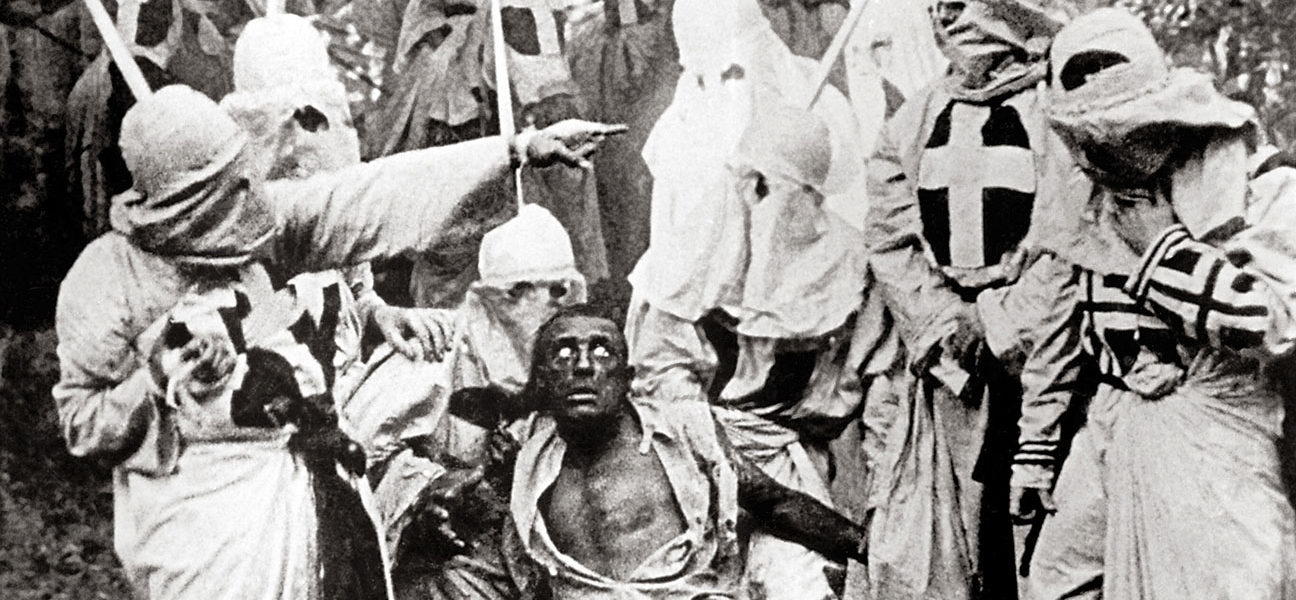A Slightly Obsessed Movie Theme Special!
COURTING CONTROVERSY
In tandem with Spiritual Sunday, I will be running a complementary series of entries today addressing some of the most divisive films in cinematic history.
A few years back I returned to South Korea after an abbreviated return to the US just in time to not vote in the 2008 elections, and just in time to not witness the immediate effects of financial and economic collapse on my homeland. For the next 4 years then (my previous sojourn had been 3), I sat out some of the most interesting times the old Chinese sage, or so the legend goes, bid that “may you live in…” (Not that I’m worried, though, as I’m sure we’ll continue to have no shortage of “interesting times” ahead.)
…
Back in Korea, I adjusted to a separation between everything I knew and liked in the waning days of 2008, some 6500 miles from home the only way I know how, really: I watched movies. Lots and lots of movies. Greatly aiding my quest for interesting viewing material was a friend who had a file-sharing program which he’d set up for a few other of us homesick expatriates. Imagine my joy one Halloween when I came home after a long contract “discussion” with my employers to find a high definition file of the 1999 documentary Wisconsin Death Trip downloaded to my laptop! It was great, and really brought what I’d been missing “home” to me.
Among the assorted miscellany of my friend’s media files—British sitcoms and police procedurals, mostly—I came across a folder marked “Disney.” Now, this is why I’m really telling you all this ‘cos when I clicked that icon to look what lay within I was flabbergasted, nay, absolutely floored to find EVERY ANIMATED DISNEY MOVIE MADE BETWEEN 1937 (Snow White and the Seven Dwarfs) AND 2007 (Meet the Robinsons), including—and pay attention here, folks—the 1946 live action/animated musical Song of the South.
…
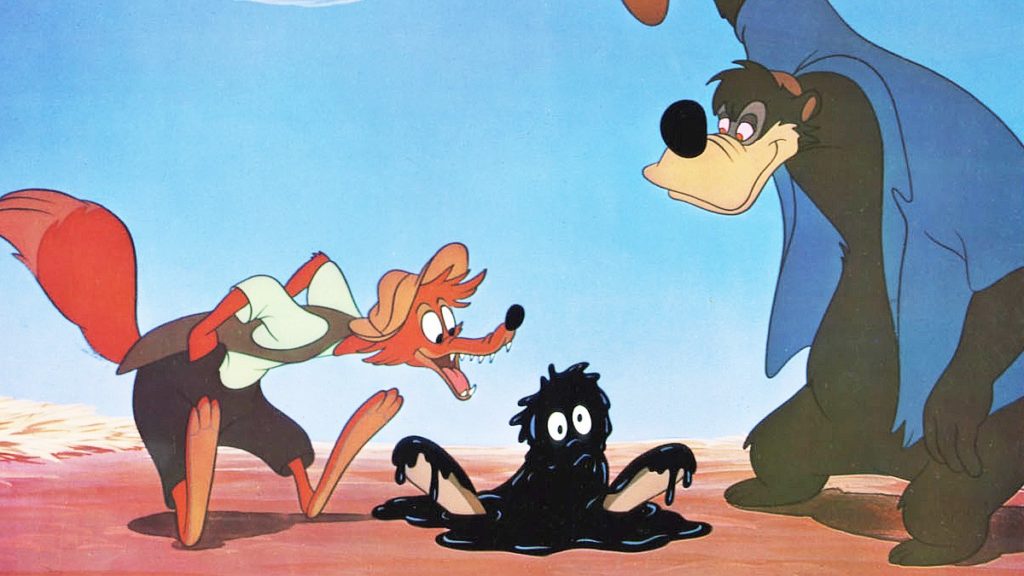
Based on the stories of Joel Chandler Harris, Song of the South combines animation and live-action musical numbers in the most enchanting Disney style to idealize life in the plantation and cotton-picking days of the Old South. Never released on any home viewing format in the US, never shown in its entirety on television, and unseen in theaters since the mid-80s, the movie, along with characters like Br’er Rabbit, Br’er Bear, and Br’er Fox, is nonetheless vastly familiar to children of subsequent generations courtesy of relentless marketing in other media (e.g. a best-selling “record-book” of the story that many might remember from when they were kids) and the eternal popularity of the song “Zip-a-Dee-Doo-Dah,” which won an Oscar for best song in 1947 and has since become an inescapable staple of elementary school music programs.
So yeah, in its nostalgic portrait of faithful mammys and subservient field-hands Song of the South is incredibly, incredibly racist; but here’s the kicker: it’s also beautiful. Gorgeous, in fact. Featuring some of Disney’s best animation in the postwar years, the live action and animated sequences are brought together seamlessly, with the Uncle Remus-spun tales of trickery and fun literally popping off the screen in gorgeous, realer-than-life Technicolor.
…
Okay, then, but the question remains: Should we bury away Song of the South in some air-pressure controlled vault, never to be seen again by human eyes—which has been what Disney has done for much of the past 20-30 years—or should it be exhibited/made available somehow for people to make up their own minds?
Dunno, but I’ll be asking a similar question about four other extremely controversial, yet artistically-accomplished films over the next four Tuesdays. In honor of that past Halloween month of fond personal memory, I’m calling ‘em TALES OF TRUE TERROR!
Should be fun.
I. THE BIRTH OF A NATION
(1915, David W. Griffith Corp., dir. D.W. Griffith)
“The blight of war does not end when hostilities cease.”
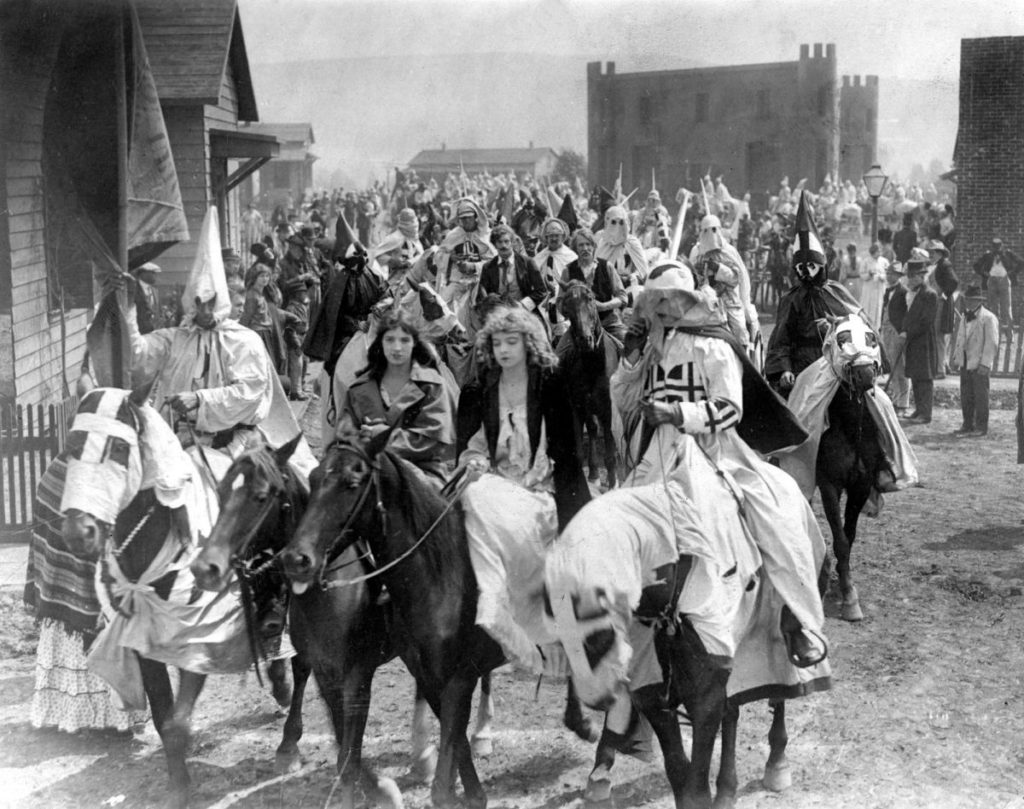
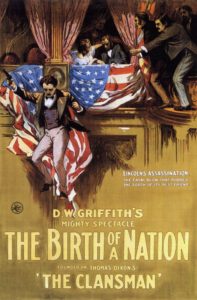 Letter to the Palladium Theatre, Milwaukee, Wisconsin, from the National Association for the Advancement of Colored People (NAACP); February 15th, 1915…
Letter to the Palladium Theatre, Milwaukee, Wisconsin, from the National Association for the Advancement of Colored People (NAACP); February 15th, 1915…
Dear Sirs,
Mr. David Wark Griffith’s spectacle photoplay, entitled “The Birth of a Nation”, has been lauded as a major advancement in the burgeoning art of motion pictures. In this photoplay, Mr. Griffith aims to present a human story of two families, the Stonemans and the Camerons, who represent the North and South respectively, and, in so doing, convey major historical events preceding and following the Civil War, focusing especially on the turbulent period known as Reconstruction.
While it is certainly undeniable that the story and manner of its presentation is not only accomplished, but powerful, representing a new sophistication and artistry in motion picture entertainment, also undeniable is that the photoplay’s offensive and abhorrent thematic content illustrates the extreme dangers of racial prejudice.
Although we strongly object to the photoplay’s inflammatory portrayal of an entire race of people as inherently childlike and evil, we are more concerned at present with Mr. Griffith’s inaccuracies regarding his and his collaborator’s interpretation of the historical record. The Ku Klux Klan, a now forgotten footnote in history, were not the White Knights Mr. Griffith presents them as, but rather a vigilante organization operating outside the law that attempted to disenfranchise the rights of our people through violence and terror.
To suggest that the Klan were the “heroes of the South” is an insult to the ancestors of their victims. We ask that you take the matter into careful consideration before exhibiting this motion picture.
Sincerely,
Executive Council of the NAACP
…
D.W. Griffith’s landmark, epic treatment of the antebellum South, the Civil War, and Reconstruction, The Birth of a Nation, has also been referred to as The Birth of Cinema. The close-up, tracking shots, cross-cutting along parallel scenes of action, pseudo-documentary recreations of famous historical events, panoramic views of battles and scenes of war, novelistic story structure and dramatic complexity, three-dimensional characters interacting in realistic settings, SPECTACLE!: Griffith codified, exploited, and packaged the full potential of an art form in its infancy to move and enlighten film audiences of nearly 100 years ago.
With this film, Griffith also gave the world its first true star, Lillian Gish (playing Elsie Stoneman, the daughter of a northern US Congressman), and ensured by shooting it there that Hollywood, USA would become the film capital of the world. So I suppose it is not an understatement to say that there is no other film as centrally important, both historically and artistically, as The Birth of a Nation.
…
But therein lays the problem. As alluded to in the (fictional) NAACP letter above, Griffith, a child of the South born a decade after the Civil War, whose father had been a Confederate war hero and who had been brought up on stories of the indignities his near relations had suffered during the Reconstruction period, regrettably found the full expression of his deeply felt, thought entirely misguided, beliefs in Thomas Dixon Jr.’s provocative source play, “The Clansman,” which cast the Ku Klux Klan—and a fictional representation of its founder, played in the film by Henry B. Walthall—as the Saviors of the South.
…
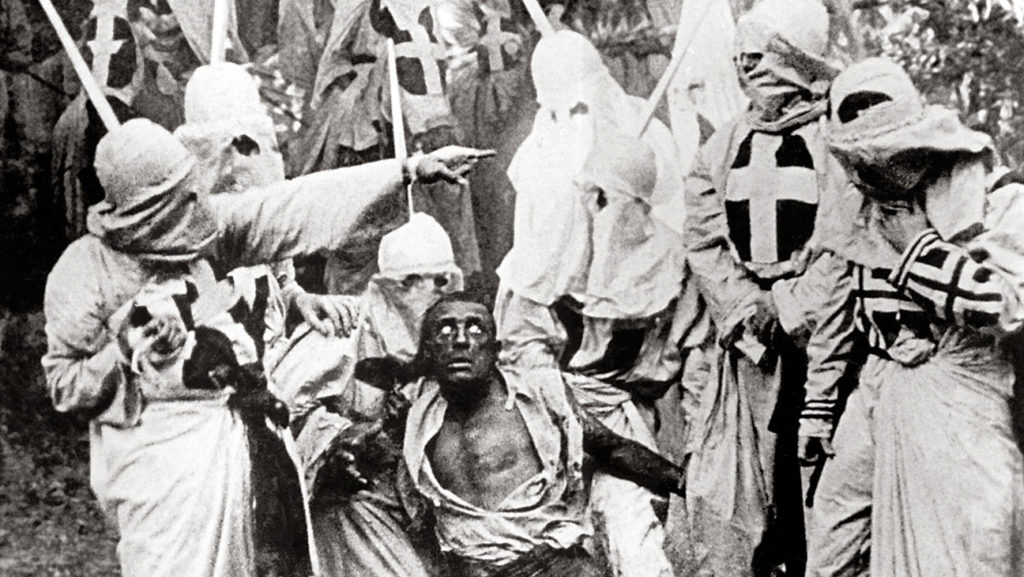
The Birth of a Nation (1915)
Directed by D.W. Griffith
Shown: Walter Long (as Gus) surrounded by Ku Klux Klan members
Just to give you a taste of the true horrors the film presents, here are a few notes I took on some particularly egregious scenes:
–The misguided northern congressman, Stoneman (Ralph Lewis), promotes an Evil Mulatto (George Siegmann) as his assistant.
–The Evil Mulatto manipulates “the ignorant black masses” and rigs the election to become federal Lieutenant Governor of the occupied South and de facto “leader of the carpetbaggers.”
–“An Historical Facsimile” of the first state congress after the Civil War, where the recently-elected Black Majority commit various atrocities including, but not limited to, drinking corn whiskey and eating fried chicken during assembly(!), lounging in their seats and putting up their bare feet on the desks(!!), and, the capper, passing a law permitting intermarriage between blacks and whites(!!!).
–The youngest Cameron daughter (Mae Marsh) is chased off a cliff, “sacrificing her life rather than her honor,” by a lustful Black Militia Captain (Walter Young).
–The Cameron son (Henry B. Walthall) receives “divine inspiration” for forming the Ku Klux Klan when he observes a group of black children frightened by a white sheet that the “young pickaninnies” mistake for a ghost.
–The Cameron son convenes the first Ku Klux Klan meeting in which he washes a Confederate flag in the blood of his murdered sister.
–The Evil Mulatto locks the Stoneman daughter (Lillian Gish) in a room after she valiantly spurns his proposal of marriage, along with his offer to make her “Queen of his Black Empire.”
–The Ride of the Klan set to a thundering Wagnerian score, in which the Klan quells the querulous rabble of “crazed negroes” with lynching ropes, guns, and by wearing white sheets.
–The Klan rides victorious as the cowed black masses slink away before the street-long row of “white knights on white steeds.”
…
With every black character in the drama reduced to a vicious stereotype, the film is uncomfortable to watch, to say the very least. Major black roles—the Faithful Souls (William P. DeVaull, Jennie Lee) who continue in their roles as slaves even after being freed; the Black Militia Captain (Walter Young) who murders a white woman and becomes the Klan’s first victim; the Evil Mulatto (George Siegmann), protégé of the abolitionist US congressman (Ralph Lewis), who manipulates his people and commits fraud to gain power in the wide-open era of Reconstruction (not to mention has designs on the Congressman’s daughter! *horrors*)—are played by white actors in blackface; as if there weren’t any black actors available to play roles of such ‘complexity’, or more likely, that no self-respecting black actor would submit to playing such demeaning/offensive roles…
The fallout of all this was that the film was subsequently used as recruiting propaganda for Southern racists and is credited as being directly responsible for the revival of the Ku Klux Klan in the late teens and early twenties. Griffith, stung by the criticism he received from groups like the NAACP, spent the rest of his career trying to salvage his reputation: following this film, and in response to that criticism, he embarked on another epic, 1916’s Intolerance, in which he portrayed the historical calamities resulting from prejudice “Through The Ages.” Another landmark film, audiences of the day found it confusing, and the latter film quickly flopped, failing to even earn back the cost of its production during its initial release.
Too little, too late, one supposes.
…
BUT!
The Birth of a Nation is still an undeniably affecting viewing experience and again, for its technique and spectacle, an absolutely inescapable part of film history. I mean, despite being absolutely horrifying, try not to watch, say, The Ride of the Klan without getting chills of artistic appreciation running down your spine.
SO… Burn, Ban or Celebrate?
Well, since I’ve *kinda* run outta room here, think I’m gonna have to plead The Fifth.
II. TRIUMPH OF THE WILL
(1935, Reichsparteitagl-Film, dir. Leni Riefenstahl)
“On September 5th, 1934/20 years after the outbreak of the World War/16 years after the beginning of German suffering/19 months after the beginning of the German rebirth/Adolf Hitler flew again to Nuremberg to review the columns of his faithful followers.”
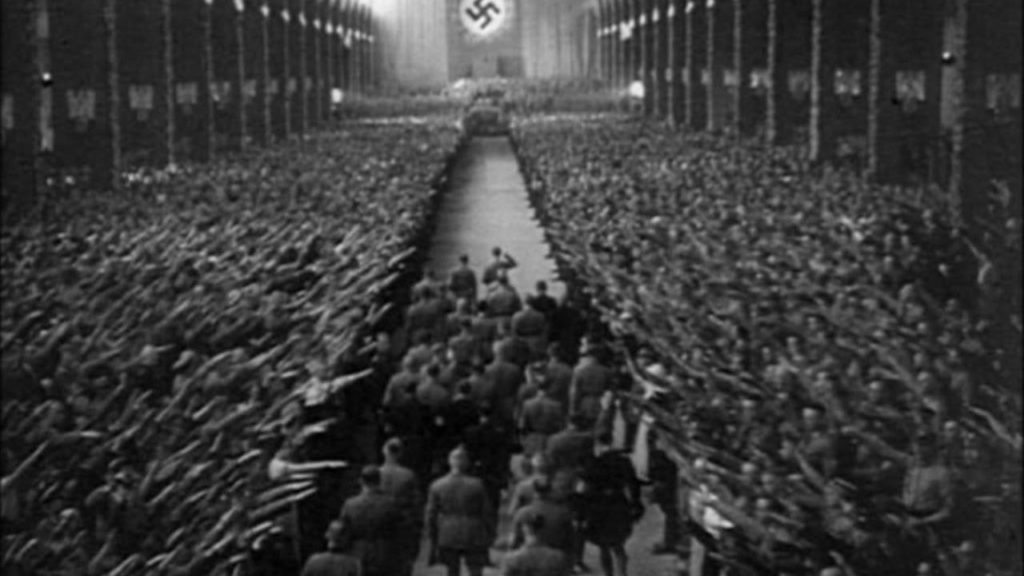
From the annals of my klutzy youth, mid-80s edition…
I should probably stress that I was never an intentionally mischievous or willfully misbehaving kid, but I nonetheless always seemed to be in *some* sort of trouble.
Like the time I pushed the lawnmower over the concrete base of the backyard fence and shattered its blades into a metal-twisted state of non-repair. Or the time I hit a small pebble with a tennis racket at the front lawn and it ricocheted off the concrete sidewalk to break both the parlor window AND a priceless glass cover of an antique kerosene lamp. Or the time I used a yard stick to dislodge a small rubber bouncy ball from the dining room candelabra and ended up dislodging the hook connecting the doohickey to the ceiling instead, thus bringing the ornate glass and brass fixtures crashing down on the dining room table. Or…
Well, you get the idea. I was a destructive klutz.
The most traumatic among my long catalog of wanton, though I maintain entirely unintentional acts of property damage was at my grandmother’s house one summer. She’d gone off for groceries or something and, left alone in a big house, I did what I usually did when left alone in a big house: I poked around where I shouldn’t have been poking around.
Naturally, I gravitated towards the attic.
Attics are the most magical places of old houses ‘cos it’s where all the old stuff ends up. A haven/heaven to which long decades of mysterious trunks, out-of-fashion clothes, broken appliances, and the flotsam & jetsam of general disuse migrates/ascends. My favorite attic-y ephemera, though, are/were dusty shelves crammed with old books, sheet music, magazines, and random piles of papers/letters.
That particular summer afternoon I picked out a random faded-flesh colored paperback from the must-shrouded shelf. I sounded out the title of the book from the spine, phonetically struggling over two unfamiliar words (italicized): “From Caligari to Hitler.” I randomly opened to a page in the back of the random tome and stared for a few moments at a picture of a short, heavyset man in a trenchcoat staring through a shop window, his homburg-hatted head encircled in reflection by a halo of knives. The photo caption (italicized) was way beyond me: “Kristallnacht.”

Peter Lorre in Fritz Lang’s M (1931)
I turned the page and was further arrested by a pair of haunting, though in this case vaguely familiar images, the first showing two parallel columns of armor-clad knights standing at attention, with the king and his retinue proceeding through the center aisle of high-romantic medieval fantasy. The photo caption read “Nibelungen.” Beneath it was an almost identical image, though this one featured more contemporary jack-booted soldiers, arms thrust forward in salute, with a trio of men purposefully striding through the center aisle of the military formation. The caption of the bottom photo read “Nuremberg.”
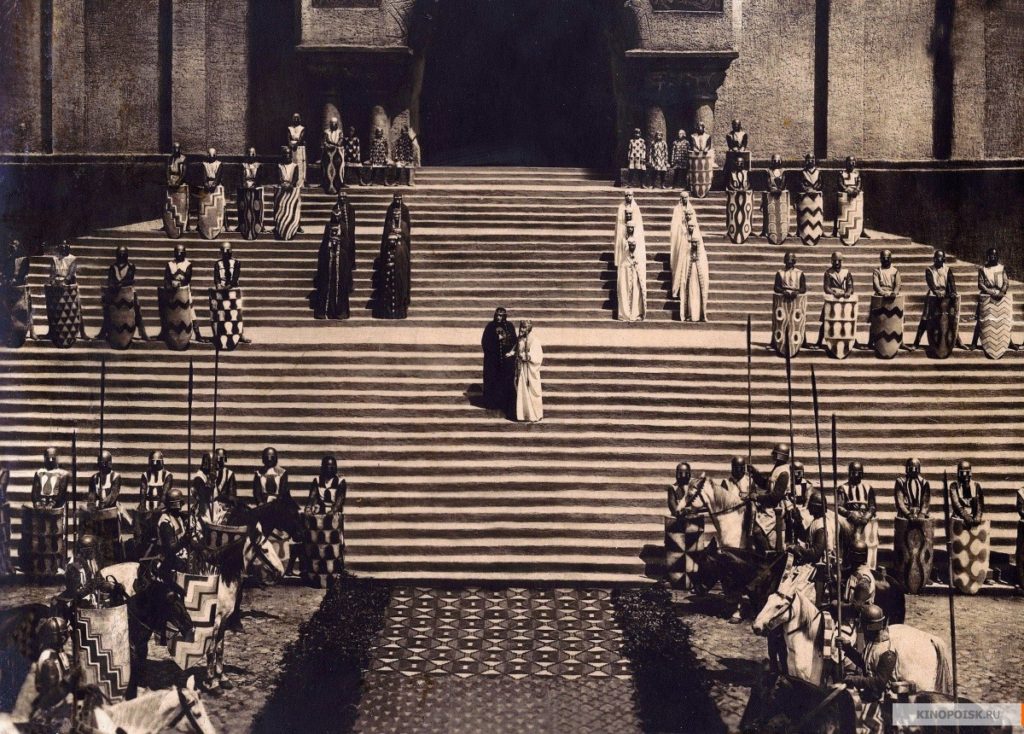
Fritz Lang’s Die Nibelungen (1924)
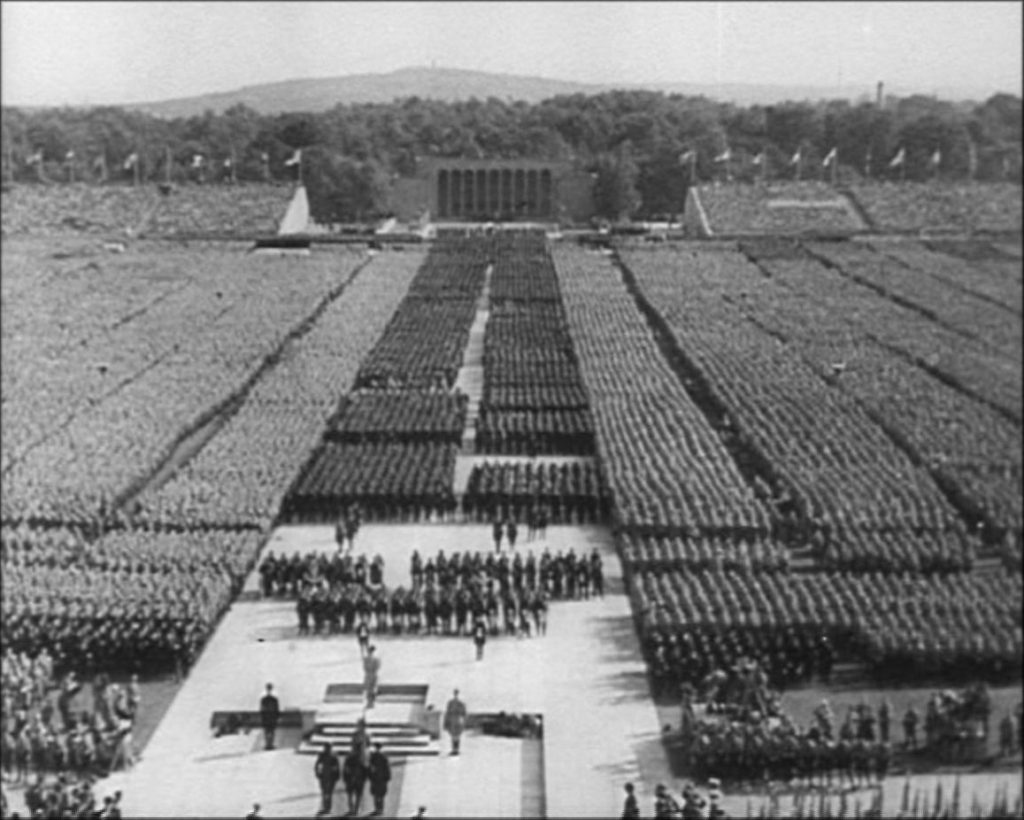
Triumph of the Will (1935)
At this point, I sat down on a crate next to the stairs and, leaning my head against the railing, the fraying rope holding the trap door aloft snapped loose with a resounding CRASH!, so severing the only means of ingress or egress into or out of the attic. (As I recall, I later had to climb out a window. Dunno how or if they ever fixed the trap door.)
Meanwhile, waiting for my grandma to get back from wherever, there I was, trapped in a scary place with a very scary book from which I’d learned five new words I’d never forget, along with several images I’d never be able to unsee.
…
THAT very long and apparently pointless ‘intro,’ as it turned out, was also my introduction to that entire chapter of history. (Well, slightly before Art Spiegelman’s comic book Maus gave me a wider historical context for the dark deeds of those saluting storm troopers, courtesy of anthropomorphic mice and cats.)
Released in 1935, to a horrified world audience, Leni Riefenstahl’s film documentation of the ’34 Nuremberg Rally of the German National Socialist Party (“Germany is the Nazi Party, and the Nazi Party is Germany!”) is, like Birth of a Nation before it , another piece of artistically-inspired filmmaking which also happens to be unequivocally evil.
Only moreso.
…
Actually, I had been planning to open this whole schmear with an epistolary exchange between “Reich Minister of Public Enlightenment and Propaganda,” Josef Goebbels and “32 year old female filmmaker, artist, photographer,” Leni Riefenstahl on the subject of the proper means by which to convey in cinematic terms the “inspiring power and genius” of Der Furher, Adolf Hitler, on the eve of his greatest triumph—the September 1934 Rally at Nuremberg—but decided, wisely I think, that to address the horrors of the time-period on its own term, from the perspective of some of the key figures who perpetuated that horror, would be, um, a *slight* mistake.
But back to the book I was trapped in an attic with when I was 10 or 11:
Entitled From Caligari to Hitler: A Psychological History of the German Film from 1914-1945, it was written by Siegfried Kracauer in 1947 with the full benefit of hindsight. I later read it for a class when I was in my early 20s and learned how the images and thematic content of movies made after the first World War and leading up to the rise of Nazism in Germany—movies like The Cabinet of Dr. Caligari(1920), Dr. Mabuse, the Gambler (1922), and Nosferatu (1922)—were later appropriated and recycled by Nazi propaganda filmmakers.
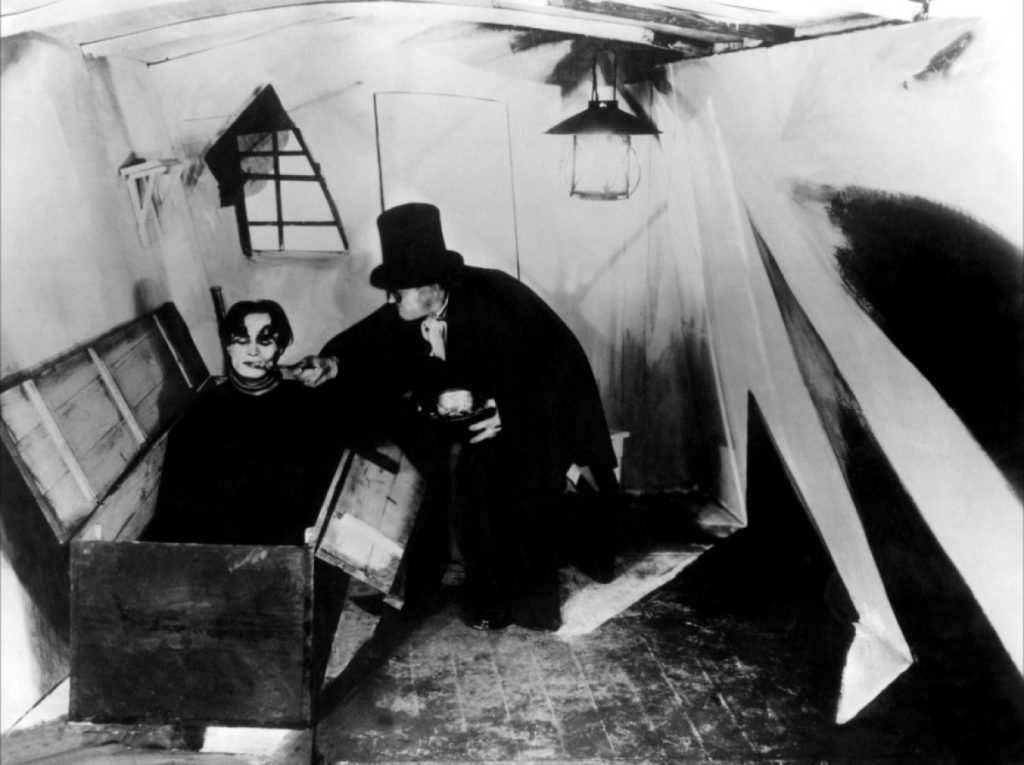
The Cabinet of Dr. Caligari (1920)
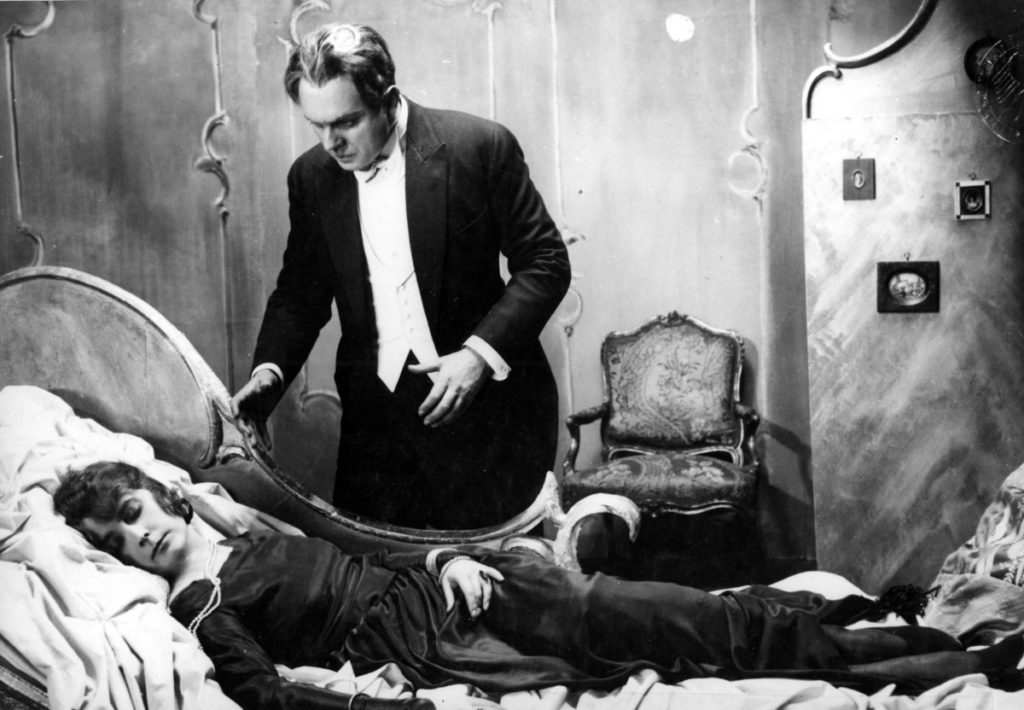
Dr. Mabuse, The Gambler (1922)
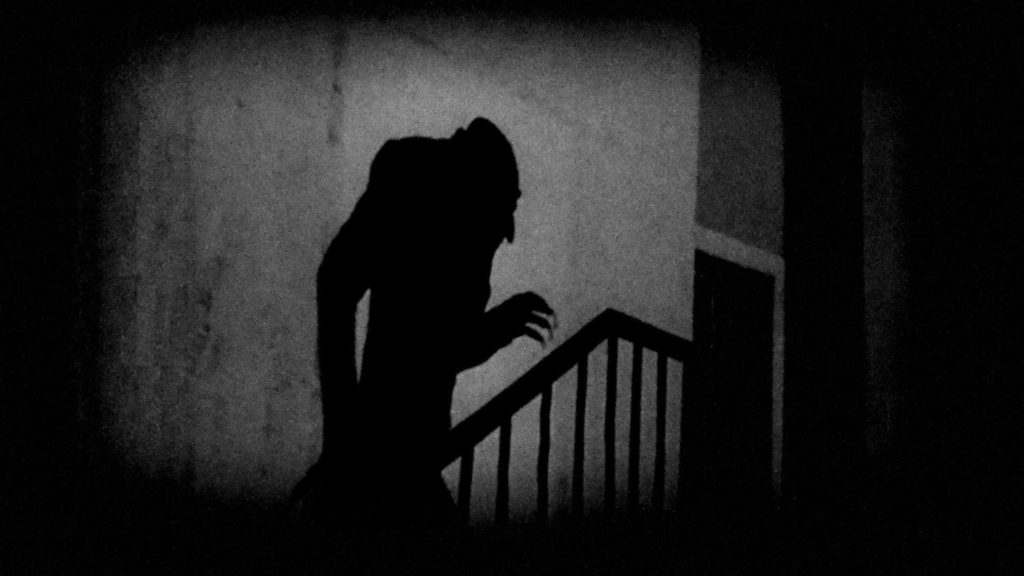
F.W. Murnau’s Nosferatu (1922)
Riefenstahl was certainly the most accomplished among the post-Expressionist filmmakers, and her images indelibly mark the mind of its viewers with their long motorcades parading up and down x-Platz and y-Strasse or pseudo-mystic/religious nighttime flag rituals lit by bonfire or hysterically shrieking demagogues framed powerfully against the sky or, indeed, the majestic cloud formations that famously open the film–through which the shadow of the plane carrying Adolf Hitler cuts like a long knife, landing at the airport to a thunderous greeting of “Heil Hitler!” as The Devil himself steps smiling out onto the platform… Yes, it’s all very troubling, but also—one hesitates to even admit it—it’s kinda beautiful.
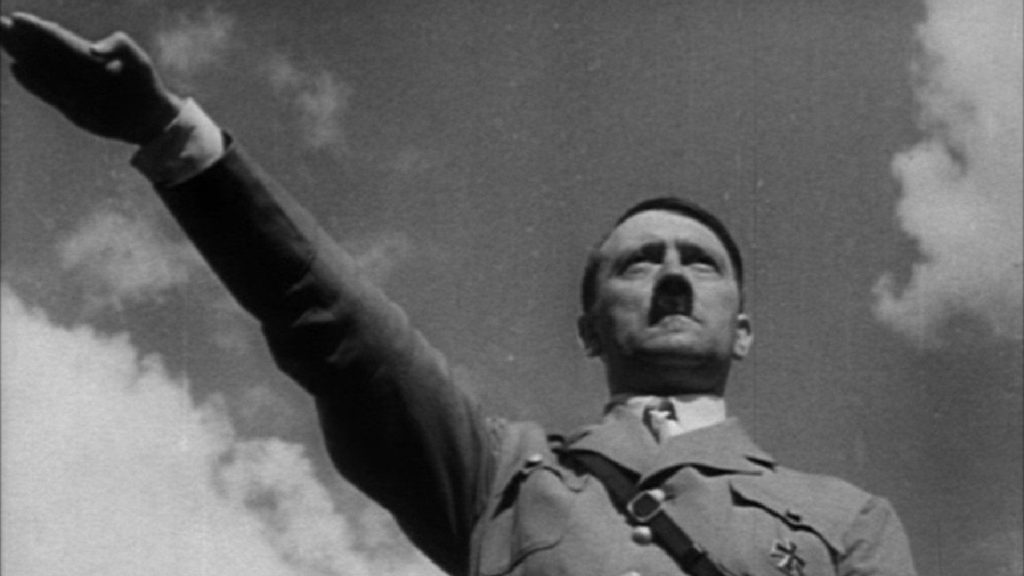
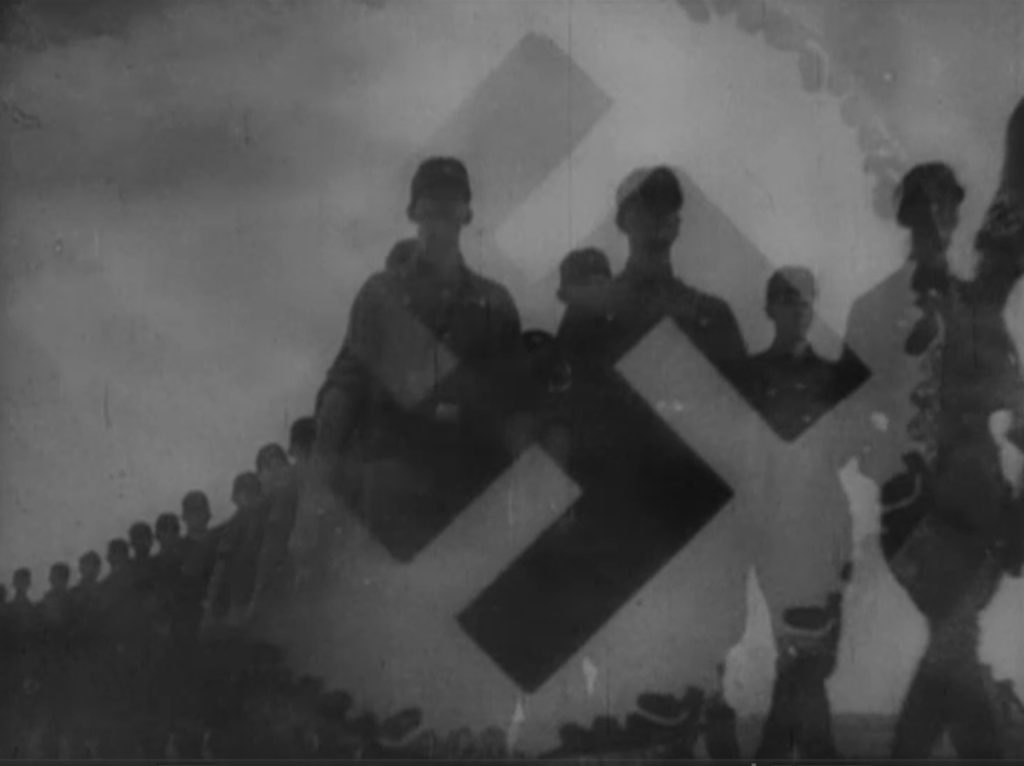
…
Returning to my long-ish intro, where I sat paging through a scary book in a dark attic while waiting for my grandma to come home, I didn’t realize till *many* years later where I’d seen those massive twin columns of saluting soldiers before. As a fun experiment, then, try googling for images combining the words “Triumph of the Will” and “Star Wars.” I’ll wager you’ll come across a black and white picture next to a colorful sci-fi/fantasy image of three figures striding purposefully down the center aisle of snap-precision, paired military formations–with Hitler, Rudolf Hess, and Goebbels replaced by Han, Chewbacca, and Luke.
Should Triumph of the Will be seen? Probably not, but as it turns out, most of us have been exposed to its imagery since, well, childhood.

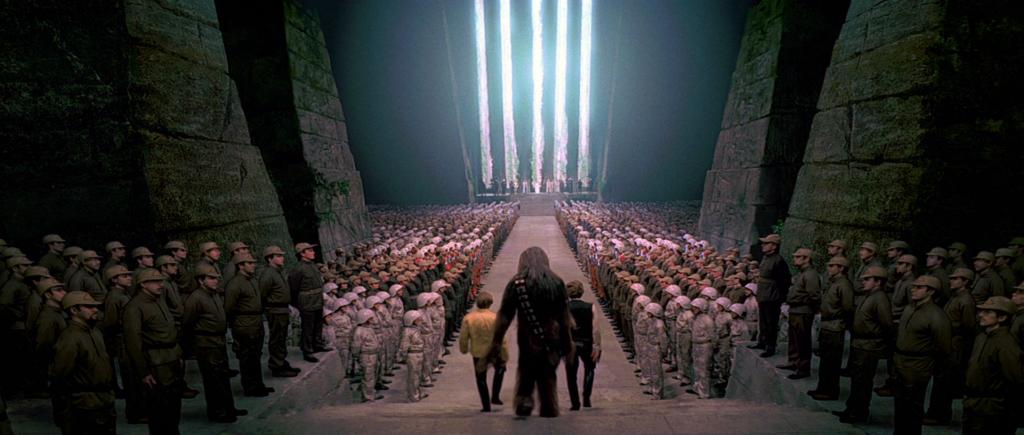
And there’s your TALE OF TRUE TERROR! for the day.
III. THE GREAT DICTATOR
(1940, United Artists, dir. Charlie Chaplin)
DER FOOIE: Democrazie, schtunk!
(Translator: Democracy is… fragrant.)
DER FOOIE: Libertie, schtunk!
(Translator: Liberty is odious.)
DER FOOIE: Frae sprachen, schtunk!
(Translator: Free speech is objectionable.)
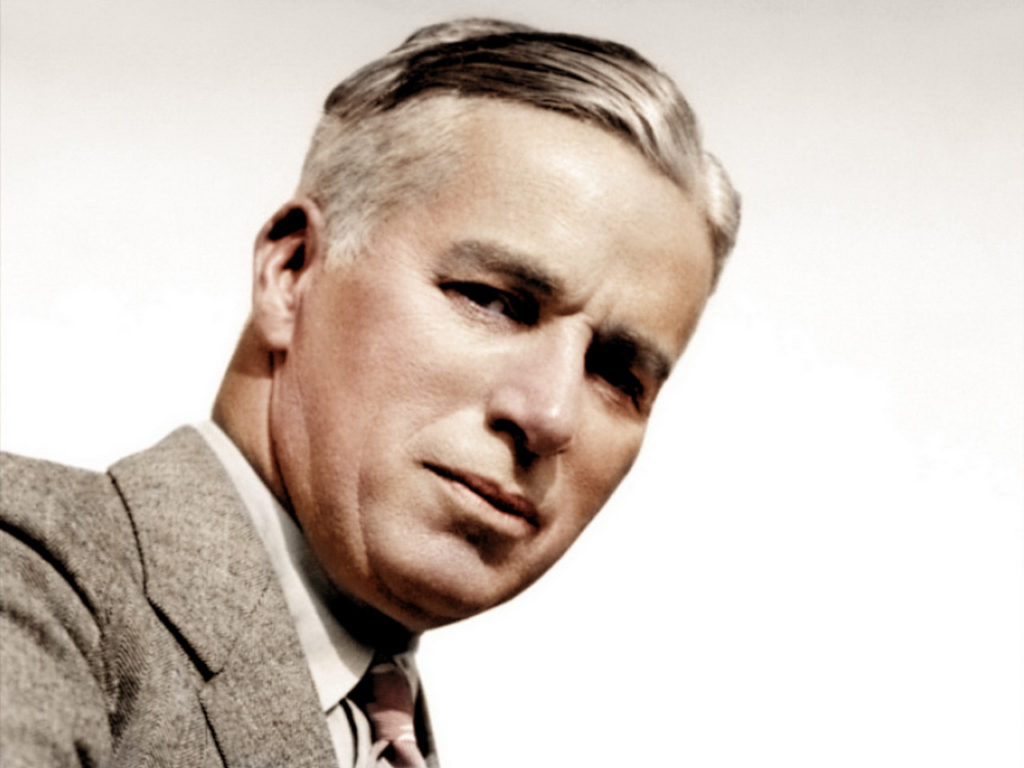
Unpublished extract from “My Autobiography” (1964) by Charles Spencer Chaplin…
After the set-backs and near-disasters that eventually resulted in the completion of “City Lights” (1931), a 2 week stay in London to attend the premiere of my film became a 16 month Grand Tour of Europe.
Villa-ing in France , the Netherlands, and Switzerland, I accepted an invitation to cross the German border in January 1932 to attend a concert of my friend Hanns Eisler’s “Medleys for Brecht” in Dusseldorf.
The postwar period in Germany had resulted in an astonishing flowering of the arts in music, drama, and cinema—in Hollywood, I counted Ernst Lubitsch and the late F.W. Murnau among my circle of close associates—but the crippling provisions of the Treaty of Versailles, particularly the economic sanctions against the country and the corruptions of the Weimar Republic, had left a once proud nation a mere shell of its former self. By this point, bread lines, inflated currency, and daily riots had given way to hate-fueled political demagoguery.
And so it was that after attending the performance at the Tonhalle Dusseldorf, Eisler and I stepped out into the cold wintry scene and were almost immediately swept into a seething mass of heavy-set, fur-clad, top-hatted, walrus-mustachioed gentlemen—resembling, in conglomeration, nothing less than an editorial cartoon representing “Capital”—shouting the slogan, “Hitler uber Deutschland!” The Industry Club across the Strasse, I gathered, had finished its libations for the evening, and the thunderous applause had been for a new political force in Germany, that of Adolf Hitler and his National Socialist Party.
Turning and twisting about in the confusion, I suppose it was Fate that decreed that I, having by this point been separated from Eisler in the tumultuous throng, should run smack dab into my Dark Double. Surprise lit both our eyes as his mustache, a vicious parody of my Little Tramp’s own, twitched in an almost comic fashion. It was only for a moment, and he and I were just as quickly again swallowed by the mob, but one imagines encountering one’s doppelganger—or Nemesis, if you will—is an experience that one does not lightly forget.
It took 8 years and 1 and a half million dollars of my own private fortune, but I eventually realized that moment when I premiered “The Great Dictator.”
…
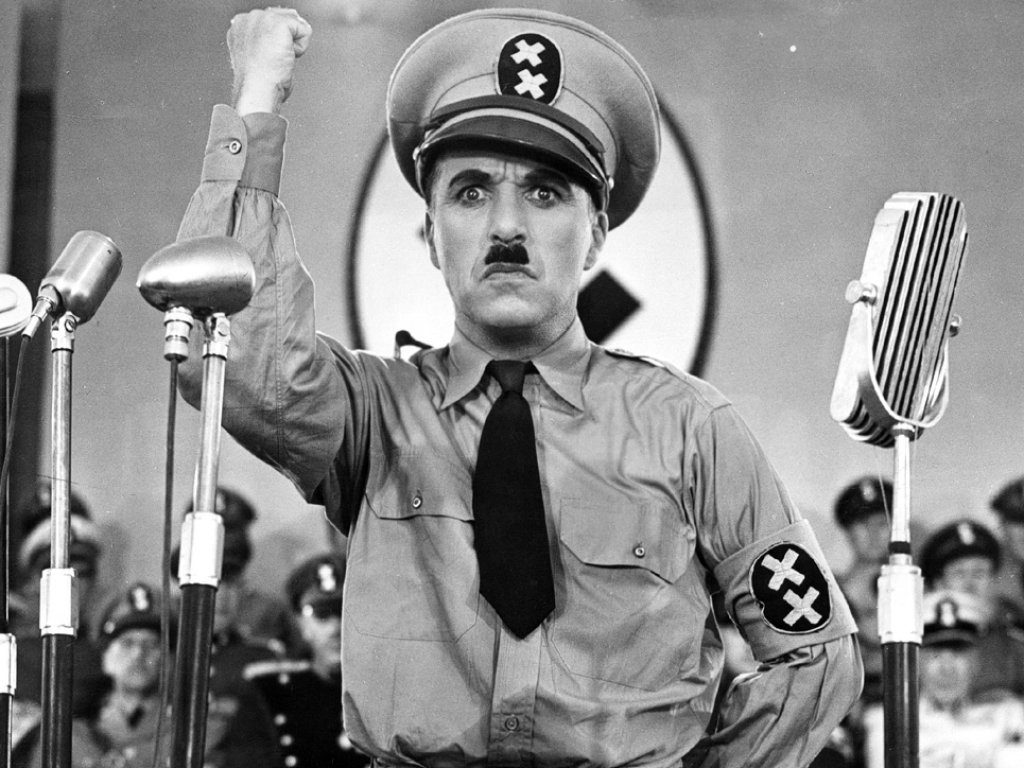
And no, the above-described encounter never actually took place, but yes, Fate had decreed that these two men’s paths should cross—in some way or another.
Born a few days apart from each other in April of 1889, both were raised in conditions of extreme poverty from which each rose to positions of great power and global influence. The similarities do not end there—a 2002 TCM documentary called The Tramp and the Dictator points out some even spookier points of comparison—but my personal favorite is that the two most famous and recognizable men of the 20th century should have, independently of each other, chosen a small, squarish patch of hair above their upper lips to represent the image they respectively wished to convey to the world.
Called, which I have on pretty good authority, a “toothbrush mustache,” one cannot help but wonder how a half square inch of bristling tuft could so effectively inspire both comedy and terror. Chaplin’s 1940 comic-tragic satire The Great Dictator, I would argue, muses on its hirsute dual nature and became the first film, following two silent films made during the sound era in 1931 and 1936, in which The Little Tramp broke his long silence to give voice to that small squirming ‘stache—enacting roles as both a comic Oppressor and a terrorized Victim.
…
Envisioned as his personal response to the 1935 Nazi documentary Triumph of the Will (profiled above), Chaplin plays the dual roles of “Der Fooie, Adenoid Hynkel; Ruler of Tomainia” and “A Jewish Barber;” between whom any resemblance, as the opening titles assure us, is “purely coincidental.” Even, as we shall soon see, the choice of mustache style.
Following 113 minutes of near-brilliant satire—in which Hitler and the Nazis are eviscerated through Chaplin-as-Hynkel’s pitch-perfect gobbledygook “speeches” (see film quote above), and such masterfully lampooning characterizations as “Herr Garbitsch” (Henry Daniell), “General Herring” (Billy Gilbert), and rival “Dictator of Bacteria, Benzino Napaloni” (Jack Oakie)—the Jewish Barber, through the convolutions of the plot, is mistaken for the Great Dictator in the latter’s moment of Great Triumph–the invasion of neighboring “Osterlich”–and the masks (and mustaches) drop as Chaplin directly addresses the camera AS Chaplin, Jewish Barber or Great Dictator no longer, in a highly-impassioned, 6 minute speech decrying “machine men, with machine hearts and machine minds.” And there the story ends, self-reflexively commenting upon itself; as direct and unequivocal as any “message” sent by Western Union.
…
Breaking the fourth wall in any artistic medium is always daring, while not nearly so often as effective, and this moment is particularly controversial among appreciators of both film and comedy. Should Chaplin have used his film, a comedy, and his character, the beloved Little Tramp, to make a purely political statement against totalitarianism and “a world gone mad”? Or should he have preserved at all costs the eloquent silence and expressive physicality of the Little Tramp character?
In other words, did even Adolf Hitler justify Chaplin in essentially destroying his most famous creation?
The answer, one cannot help but think, lies in the ‘stache: equally ridiculous AND terrifying, and however one might personally view the advisability of hair arranged over the upper lip, the unfortunate coincidence of an upper lip coiffure nonetheless required SOME sort of response.
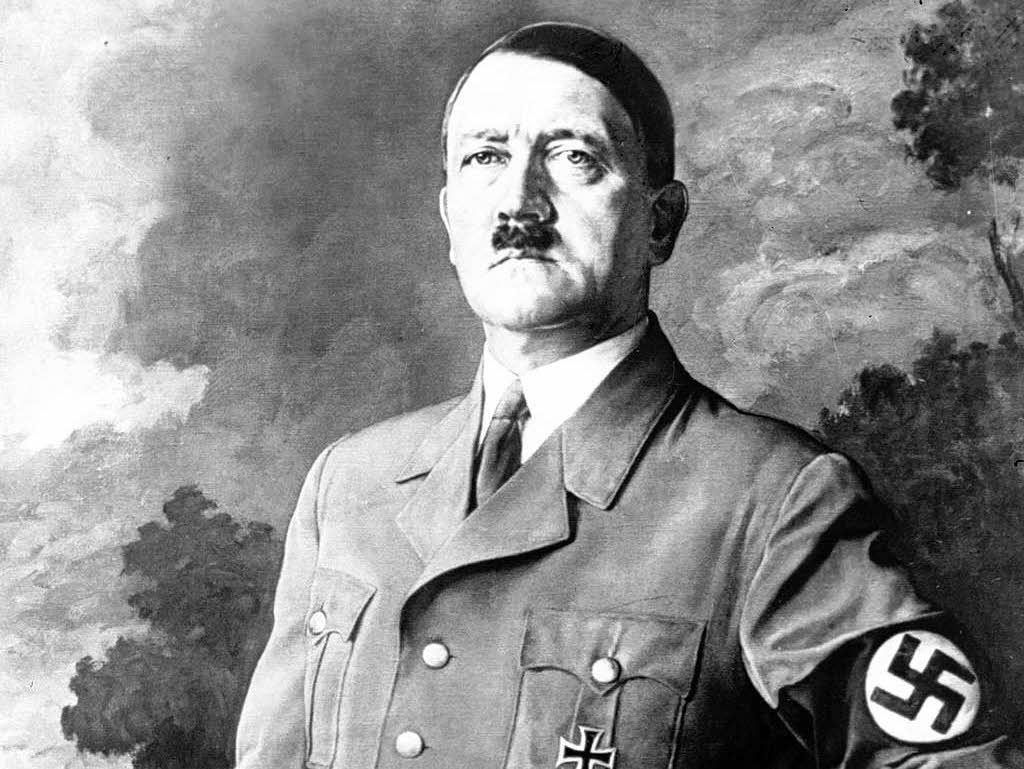
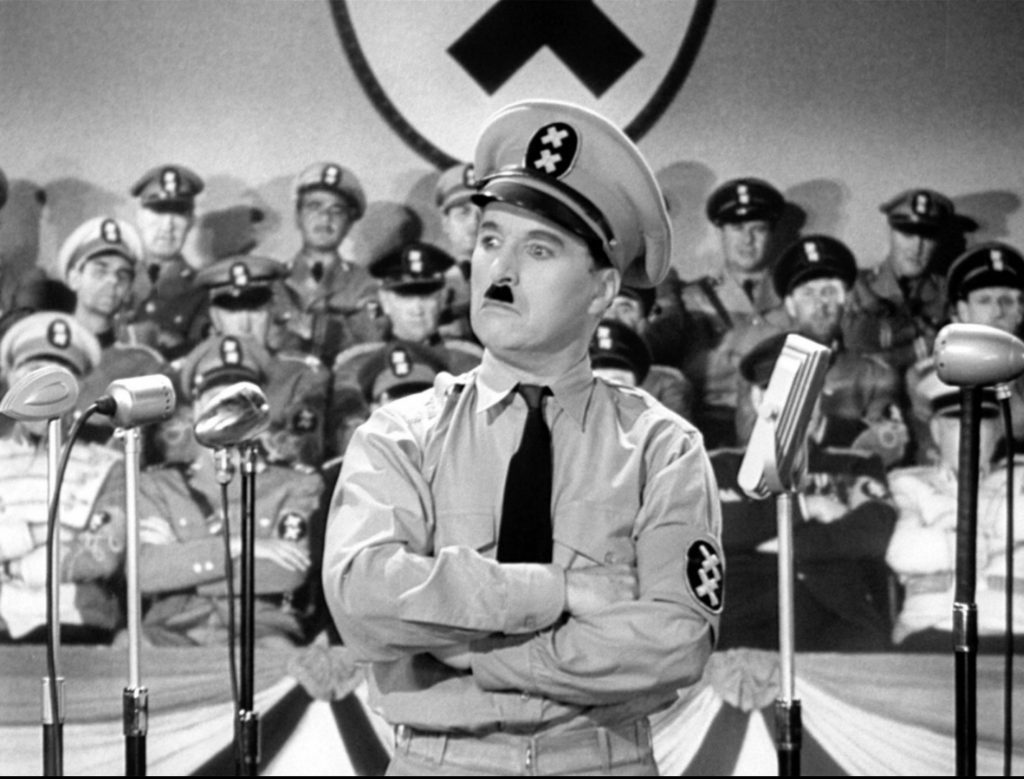
And thus one of the great lessons of the 20th century: NEVER underestimate the importance of facial hair.
IV. A CLOCKWORK ORANGE
(1971, Warner Bros., dir. Stanley Kubrick)
“I was cured all right.”
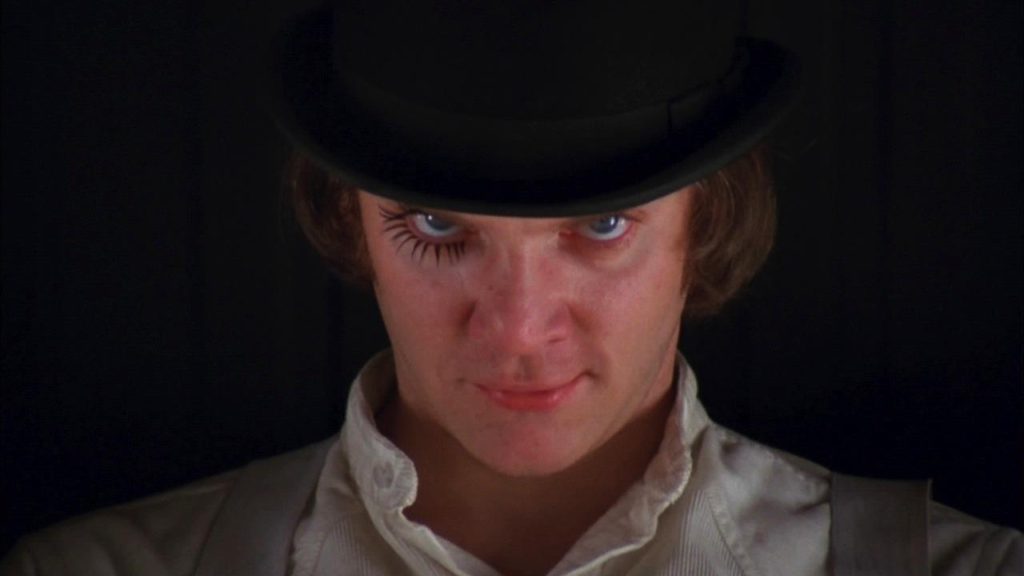
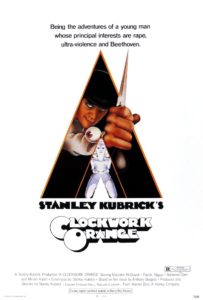 “Heatherstonehaugh(“Hanshaw”), Bough(“boff”)ley-on-Heath, Blaughk(“blecch”)enshire; 13 January 1972″…
“Heatherstonehaugh(“Hanshaw”), Bough(“boff”)ley-on-Heath, Blaughk(“blecch”)enshire; 13 January 1972″…
An old man was beaten near to death by a roving gang of youthful miscreants dressed in white puffy shirts and pantaloons, Jolly Roger tri-cornered hats, and black velvet eye-patches. Whilst whistling old sea shanties, the assailants appeared to have repeatedly hit the old man over the head with the blunt end of cutlasses, sheathed in red cummerbund sashes ‘round their waists, before one of their numbers carved a ‘YP’ (‘Young Pirates’) into the vest of the old man’s jacket.
“Forcester(“fooster”), Gagdalen(“gaudlin”) College, Oxbridge; 26 March 1972″…
The usually riotous Boat Race Night festivities of pinching policeman’s helmets and streaking nude through The Quad were disrupted when a group of anarchist terrorists dressed as characters from Lewis Carroll’s “Alice in Wonderland”—including The Mad Hatter, The March Hare, The White Rabbit, and, the apparent leader of the group, Alice herself—dropped a cherry-red bomb marked “BIGGER” into the Ghames River from over the Shutney-Wortlake Bridge. Three Oxbridge oarsmen lost their lives and the badly-shaken coxswain, Sir Neville Fotheringay(“fungee”)-Phipps, who caught a piece of flying stern in his throat, is feared to have lost his ability to shout “PULL!” through a megaphone ever again.
“St. Amoughn’s Toffam (“cinnamonstomb”), Wodebeaugth (“woodbath”), Yeicestermeyeour (“yestermirror”); 20 April 1972″…
A peaceful Sunday afternoon in Merrie Olde Englande’s Quaintest Village (5 years running) was broken when a motorcycle gang of armor-clad “medieval knights” roared into town and commenced breaking storefront windows and skewering pedestrians with jousting sticks. A sextet of female performers from the petrol-powered troupe, clad in nothing but bell pads and wielding lutes, pipe & tabors, proceeded to dance ’round the Maypole in the Village Square. All in all, it was a horrifying spectacle.
“Lord Miles Beresford B’Steaird (“no comment”), addressing the House of Lords; 7 May 1972″…
Clearly, gentlemen, the recent outburst of outrages across this Great Nation can be traced to one source: the January premiere of the Stanley Kubrick fil-um of the Anthony Burgess nau-vel, A CLOCKWORK ORANGE. Heretofore, violence and depravity have never been so attractively rendered nor so sensationally presented. As such, Kubrick and his collaborators have, unfortunately, succeeded in inspiring Our Nation’s highly impressionable and fancy dress-prone youth to wanton acts of destruction and terror. It is a slap in the face not only to art and culture, but to the fundamental assumptions upon which government and society is based. We ask, therefore, that this highly dangerous and powerfully suggestive work of anti-art be withdrawn from British distribution and subsequently BANNED!
…
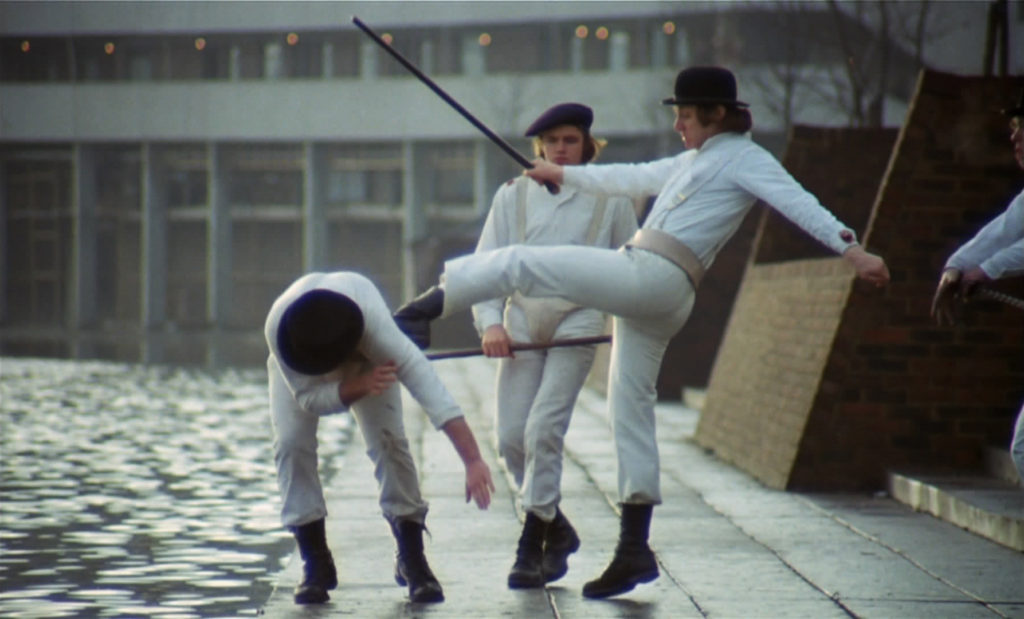
Well, that was fun. And, again, BANNED IN BRITAIN! has such a pleasant ring to it, doesn’t it? In any event, any film that has earned the distinction has also ensured its smashing worldwide success… Which is exactly what A Clockwork Orange was in late 1971 and in its 1973 re-release, despite receiving an “X” rating during its original run in the United States.
In truth, it was American-expatriate director Stanley Kubrick who, after receiving death threats and having his Hertfordshire home picketed, made the decision himself to withdraw the film a month after its premiere and subsequently refuse its distribution anywhere within the country in which it was produced. (Only available within Britain on bootlegged or dubbed copies for the next 27 years, the ban was finally lifted a few months after Kubrick’s death in 1999.)
…
So, droogies, what was all the furor about anyway, eh?
Welly welly welly, first you’ve got a charming, James Cagney-inflected sociopath in Young Alex (Malcolm McDowell) who, as “Humble Narrator” and roving youth gangleader, invites audience identification as he beats, rapes, and murders his way—often while singin’ & dancin’ Gene Kelly-style—through the first 40 minutes of sexually over-suggestive, pop art design-inspired, Beethoven & classically music-scored mayhem. Attractively guised in a codpiece and suspenders, bowler hat, white pajamas, black boots, and wielding a jaunty ball-tipped cane, never has violence and anti-social behavior looked so darned good…
Next, Young Alex is finally caught for his, um, “youthful indiscretions” and invites further audience identification, even sympathy, as he becomes unfortunate victim to the dystopian, lawless state of the near future: conditioned against his will to extreme aversion to violence through the terrifying “Ludovico Technique”–which involves being administered psychotropic drugs while strait-jacketed, hooked up to bewildering headgear, having one’s eyes wired open, and being forced to watch unpleasant movies not very much unlike the movie we are watching.
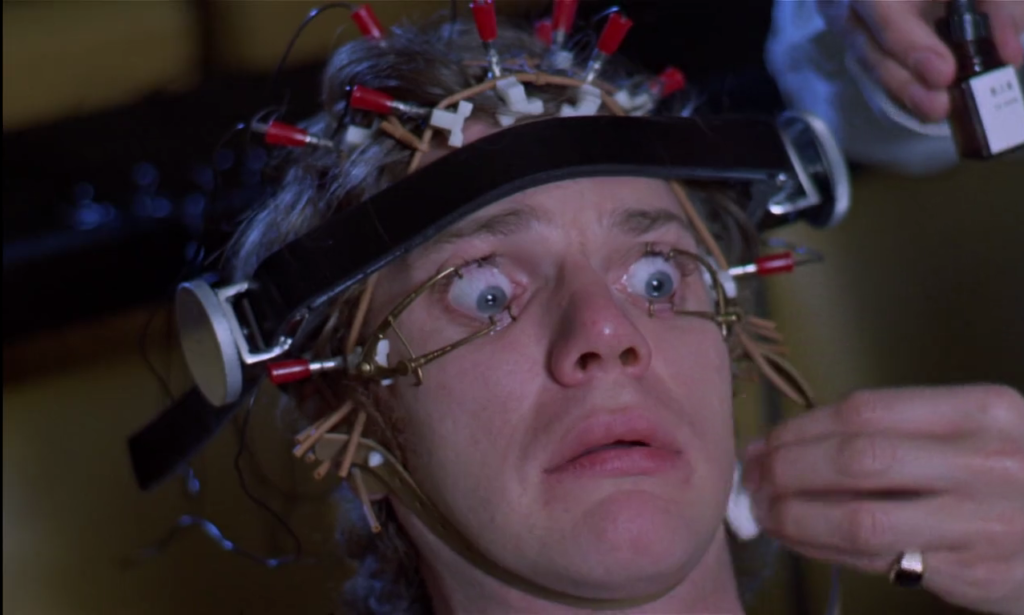
And so! As Alex becomes victimized upon his release by the very people whom he previously victimized (notably, a Ninth Symphony-torturing writer, Mr. Alexander; Patrick Magee), the audience becomes positively (or negatively, depending upon one’s point of view) enraptured at the film’s climactic moment of “triumph” in which Young Alex is administered a “cure” by the government who had previously used him for their own ends (see film quote above), “free” to rape and pillage once more!
…
Actually, I had been intending to write about another Kubrick movie this week or next, 1980’s The Shining, but the release of a documentary a few years back, “Room 237,” which concerns all the wacky theorizing that has surrounded that monumentally mystifying movie over the years, effectively put the kibosh on any wacky theorizing I might indulge in myself regarding that film. So I’m stuck here with A Clockwork Orange…
And it’s not a bad choice as it certainly has invited more direct controversy than any other single entry in Mr. Kubrick’s 13 film oeuvre. While most see A Clockwork Orange as a satire on the oppressive, totalitarian maneuverings of governments gone made with power and state-sponsored terror—not unlike Orwell’s 1984 or Huxley’s A Brave New World, say—I think one misses a wider agenda on the part of the original novel’s author, Anthony Burgess, as interpreted by director Kubrick.
Holocaust scholar Hannah Arendt pointed to the “seeds of barbarity” present in even the highest expressions of culture and art and, in particular, how the enlightened Germany of Beethoven, Goethe—and, even more appropriately, Wagner and Nietzsche—could have possibly engendered the Nazi State: a well-ordered, even aesthetically-pleasing, Empire of Crime perverting high philosophy, literature, and art–the fruits of the most culturally-advanced nation in Western Europe–in order to inspire, and even justify, mass murder. (The image of an impromptu Concentration Camp orchestra playing Fugues by Bach while fellow inmates are marched into the gas chambers springs to mind.)
So, on a much much smaller scale, as we follow this classical music-loving young thug about on his daily rounds, and acts of extreme “ultra-violence” are cinematically exploited for their most “beautiful” expression (think, say, the slow-mo scene where The Droogs take a “pleasant stroll” along the Thames and Alex, um, “reasserts” his leadership), one can’t help but wonder if Kubrick and his A-list group of collaborators have gone too far before The Viewer unaccountably finds him or herself on Alex’s Side, and actually deriving pleasure, however innocent, from his dark doings…
Quite sorry for getting all like heavy at the end there with wacky theories and so forth, but THAT, dear droogies, is a matter Your Humble Narrator isn’t touching with a ten foot pole.
An Epilogue: THE LAST TEMPTATION OF CHRIST
(1988, Cineplex Odeon Films/Universal Pictures, dir. Martin Scorsese)
“If you look inside me you see fear, that’s all. Fear is my mother, my father, my God.”
–The Last Temptation of Christ (movie)
“What is ‘truth’? What is ‘falsehood’? Whatever gives wings to men, whatever produces great works and great souls and lifts man’s height above the earth—that is true. Whatever clips man’s wings—that is false.”
–Nikos Kazantzakis, The Last Temptation of Christ (book)
“It is written, Man shall not live by bread alone, but by every word that proceedeth out of the mouth of God.
–Matthew 4.4
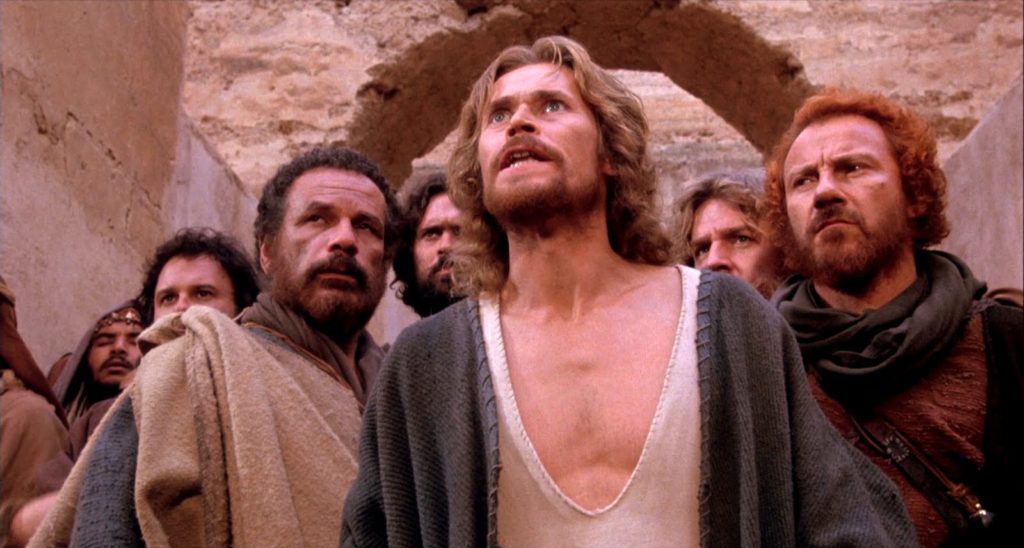
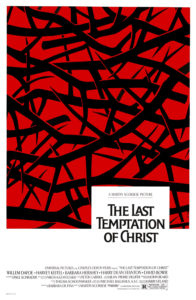 Another trip down memory lane…
Another trip down memory lane…
When I was about 10 the small town Presbyterian church my family had attended for 3 generations got a new minister, our first female minister in the church’s 100 year history. This was a church where families still held more or less “reserved” pews, the hymnals held no hymn that was less than 50 years old, and most of the deacons and elders of the church had held their positions for 20 years or more. In other words, this was a church that was not one to break with tradition, but for some reason in the late ’80s decided this was exactly what they should do.
Rev. Julie was an interesting choice for this church because, though young, she came from a missionary evangelical background—she had spent several years in a leper colony in the southern part of South Korea where she met her husband, Young-man, a son of the colony’s stewards—and held views, both socially and theologically, that could best be described as “non-traditional.” Progressive, even.
She quickly became known for her “causes.” Early on, she and a few like-minded cohorts decided to protest the ‘beer tent’ at our town’s annual Fireman’s Festival by dressing up as sad clowns and handing out disapproving cartoon pamphlets at the entrance. The following December, she took over the Christmas Play with one she had devised herself—complete with dancing angels, close-harmony singing shepherds, and a grand processional trio of kings leading ‘canopied’ camels (held up by three kids under the canvases—with the tallest kid in the middle being the ‘hump’). Another time, during an Easter service, she performed some sort of Rite of Spring in lieu of a traditional sermon, dancing in the aisles to (recorded) classical music and hurling about crepe paper banners to parishioners with legends like “Rejoice!” and “Believe!”
To a preteen, I must admit, this was all quite amusing–if a little, um, weird.
So when it came time a few years later to start taking Confirmation classes—every Wednesday, I recall—I was both eager and wary to see what Rev. Julie would possibly come up with. I was not disappointed: spaghetti dinners, meditation sessions, ping pong tournaments,… even Friday night slumber parties in that great old barn of a church in which there were, quite literally, bats in the belfry!
But my favorite was, of course, Movie Night. Once a month during the 2-year Confirmation period I think we saw, among many others, Brother Sun, Sister Moon, Romero, The Elephant Man… and, the reason I’m telling you all of this, the one we most emphatically DID NOT see, The Last Temptation of Christ.
But I do recall that Rev. Julie did in fact make the recommendation to us, calling it “the most profoundly spiritual movie ever made,” and even left a VHS copy on the church’s spindle of ‘check-out’ materials should we want to take it home and watch it with our parents. Alas, I never did, but I did catch up with the movie several years later and, after having a little more perspective on the controversy surrounding the film, I was not disappointed.
To this day, it strikes me, privately, as very much a “Rev. Julie movie”: it stirred up a lot of trouble and seemed quite unashamed about doing so!
…
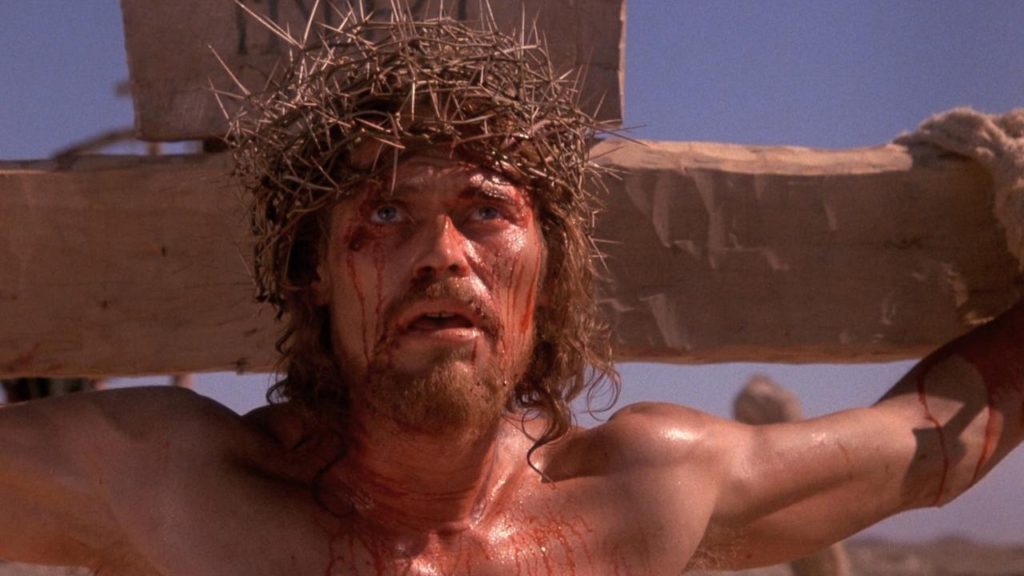
Martin Scorsese’s 1988 film adaptation of the 1953 Nikos Kazantzakis novel, The Last Temptation of Christ, is quite possibly the most controversial movie made within the past 30 years. Condemned upon release by the Catholic church, decried by several Christian fundamentalist groups, its premiere was greeted with picketing, rioting, and a lot of angry press, culminating in the tragic firebombing of a movie theater in Paris, France that was showing the film. Years following the release of the film, major distributors refused to carry it, several theaters refused to show it, and one major home video rental chain, the now-defunct Blockbuster Video, refused to put it on their shelves.
So, the persistent question of this series of write-ups, what was all the furor about, anyway? In preparing for this particular write-up, not only did I re-view the film (twice), but I also read, for the first time, the novel on which it was based. Screenwriter Paul Schrader (who had previously written Taxi Driver and Raging Bull for director Scorsese) liberally adapted the 500 page Kazantzakis novel, condensing and re-structuring the narrative where it seemed appropriate, but retained the core elements of the author’s reinterpretation of the Gospels which had then-similarly infuriated church leaders, resulting in the author’s excommunication from the Catholic church, and which delayed its translation/publication into English until after the author’s death.
Specifically, the controversies surrounding the book, and subsequently the film, are narrative and thematic elements relating to “the incessant, merciless battle between the spirit and the flesh” in the physical reality of Christ when he walked on Earth. Kazantzakis’ Christ is one who is unsure of himself, motivated by “pity and fear,” an all-too human, but yet transcendentally divine, presence—conflicted, reluctant; though immensely powerful—who is nonetheless intimately acquainted with what he has come to free mankind from: namely, sin.
In the early scenes, he, the “carpenter’s son,” is shown building crosses for the Romans and assisting them in a crucifixion of a fellow Israelite; later, he embarks on his ministry not entirely certain whether the “voices” and “torments” he receives, “like a great bird of prey clawing into [his] skull” are from the God or the Devil; still later, he begs his strongest (and most faithful) disciple, the Zealot and warrior Judas Iscariot, to betray him to the Romans in order to fulfill his ministry.
These are departures from the Gospels, which one imagines did not endear itself to its critics, but it is undoubtedly the narrative’s penultimate sequence that represents a complete, heretical break from the teachings of most major Christian sources of authority: Jesus, in a dream or vision of sorts, receives a visit from his “Guardian Angel,” steps off the cross, puts aside his ministry, and lives as a man—marries, has children, works, grows old—before realizing the “Angel” is in fact Satan in disguise, and thus his Last Temptation, and so breaks the vision and returns to die on the cross; his life and purpose now “accomplished,” representing a spiritual victory over the temptations of the flesh.
…
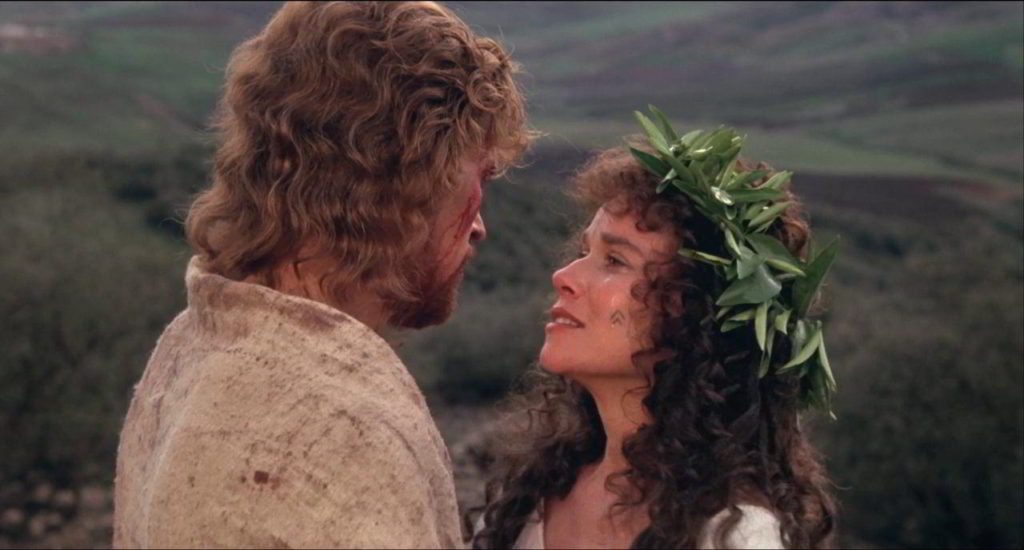
Christ and Magdalene, in Jesus’ Last Temptation dream-vision
Now, it is one thing to read about this, and still another to be shown it.
And that’s where we (finally!) get to the film itself. In preparing for this write-up I also re-read the Gospels and, while reading them, tried to focus very hard on Christ as a living, breathing person wandering about Galilee and its environs. What would he be like?
The consistent point between all four accounts of his life, ministry, death, and resurrection is Christ’s tendency to illustrate his teachings with characters that may or may not have lived, and incidents which may or may not have happened, but which are nonetheless all true. The sower casting seeds in the field. The prodigal son who returns to his father’s house and favor. The faithful steward who wisely (and correctly) sets a table for his master’s coming.
Parables, of course. The Jesus of the Gospels is a master storyteller and, like all storytellers, places thoughts and ideas in an imaginative context, thus spurring subsequent discussion, interpretation, and debate. (Which, obviously, is still going on today.) In cinematic terms, to be shown a challenging sequence of images adds yet another degree of immediacy.
And it is one that this particular director, Martin Scorsese, was well prepared for. In his earlier Mean Streets (1973), Scorsese depicts a low-level Mafia enforcer imagining the fires of Hell while holding his hand over an open flame; in Taxi Driver (1976), a God’s-eye-view (i.e., a tracking overhead shot) on a scene of blood and carnage evokes the suffering and pain which precedes salvation; in Raging Bull (1980), a boxer shadowboxing in a ring becomes an improbably touching metaphor for a weak, troubled man trying, and failing, to effectively fight his own demons. (In Scorsese’s first studio film, Boxcar Bertha (1972), there is even a dream sequence that includes a crucifixion!)
From the blood splashing across Jesus’ face in an early scene as he holds the Zealot’s feet in place, and a Roman centurion nails them to the cross, to the penultimate scene where an aged Jesus drags himself on reopened wounds from his deathbed back across the field to Golgotha, Scorsese’s intimate, sensually detailed style of filmmaking makes for a very different sort of religious epic. So I tend to think of Scorsese, at least in this phase of his career, as a deeply spiritual filmmaker who introduced religious elements to his movies—consciously or unconsciously, and perhaps resulting from his Italian-Catholic upbringing—in a unique and challenging manner.
And all the more value for it. Willem Dafoe, I suppose, is no one’s idea of Jesus, Barbara Hershey is an earthy and sexual Mary Magdalene, experimental theater director Andre Gregory is a raging inferno, a true “voice in the wilderness,” as John the Baptist, pop star David Bowie makes a rather unlikely Pontius Pilate—and the less said about a heavily Brooklyn-accented Harvey Keitel as Judas Iscariot, the better—but it’s all completely unexpected. As is a lush electronic score by former Genesis frontman Peter Gabriel, vivid and heavily-saturated photography from Michael Ballhaus, and sharp, jagged scene-cutting from editor Thelma Schoonmaker.
…
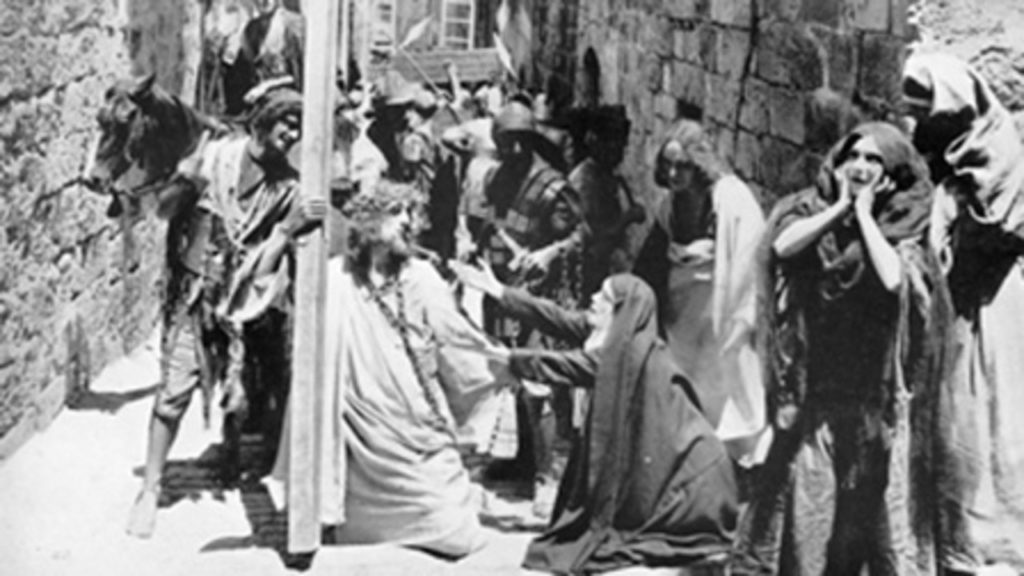
From The Manger To The Cross (1912)
This Slightly Obsessed Moviewatcher has seen many a religious epic depicting the life of Christ—from 1912’s From the Manger to the Cross, through Cecil B. DeMille’s 1927 King of Kings, to the super-productions of the ’60s like the 1961 King of Kings and 1965’s The Greatest Story Ever Told—and, while most have their merits, relatively speaking, very few (or none) manage to convince one that Jesus was a flesh-and-blood person who walked around, told stories, ate and drank with ‘low company,’ or was anything approaching a human being with desires or feelings. Watching H.B. Warner, Max von Sydow, Robert Powell et al., one imagines them floating across the screen, almost as if their feet aren’t touching the ground. (Off-topic, but I’d suggest a 1969 movie, The Milky Way, by that playful surrealist, Luis Buñuel—he of the famous “Thank God I’m an atheist” comment—that contains possibly the very first screen depiction of a more realistic and ‘earthy’ on-screen Christ.)
Perhaps I’ve emphasized the more dramatic instances of Christ’s more human qualities in Scorsese and Kazantzakis’ Christ in this write-up, but I would nonetheless like to make clear that, if I haven’t already, that the Christ of The Last Temptation, precisely because he is so unexpectedly and realistically human, is all the more powerful for his ultimate transcendence of his frail humanity into something quite Other.
…
Once again, in a movie that tends to shock and upset one’s expectations, the impact of such a work of art—whether as a book or film—depends on its readers or viewers being open to the experience of their faith, beliefs, whathaveyou being challenged. The Last Temptation of Christ aims to depict the Gospels in a new and different way, one that may not always be comfortable for its readers or viewers, but which should nonetheless provoke thought, discussion, and debate that will be useful, and ultimately illuminating.
Personally, I will always associate this movie with my confirmation pastor, Rev. Julie, dancing down the church aisles at Easter: it made me super uncomfortable, but it did do something to break down some of those staid and suffocating traditions of the past!



